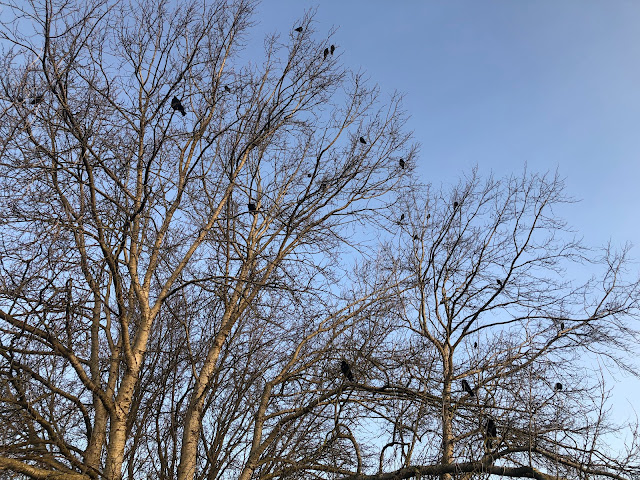 |
| Tulips have started to flower already! |
It's a fabulous season, from the daffodils and violets blooming to the whole garden visibly coming back to life. But it's the magic held in a few packets of seeds that holds the power to excite. I love every stage of the process from sowing the seeds, the thrill of seeing them germinate and then nurturing my plant babies into maturity. (And then, of course, eating some of them. Although I often find the plants so beautiful that I can hardly bear to denude the garden of their loveliness.)
So, on that basis, February was pretty exciting despite torrents of rain; the winter was relatively mild here in the UK south so February saw the first seeds being sown here in Veg Patch Villas.
I poopoo-ed the advice of the 'experts' telling me not to sow until mid March. I worked on the assumption that if it all failed, I would have time to start again. So ... into little Jiffy coir pellets on Valentine's Day went seeds of tomato, chilli, aubergine, and lunchbox cucumbers. Cosmos and courgettes were sown in the last days of February and Tagetes (marigolds), leeks and physalis (Cape Gooseberry) were started in module trays in the first week of March.
Outside, at the beginning of February, I filled the gaps between overwintered parsley and chervil in the Veg Trugs with spinach and radish - both of which are coming along nicely. The soil in the Veg Trugs is fairly free draining so the seeds probably enjoyed the regular downpours and sheltered location. I've not grown spinach in early spring before (who knew it was so hardy!) but it's worth doing as it will bolt more readily in hot weather. Another lesson learned.
Broad beans that I sowed into pots at the beginning of December and germinated on my balcony were planted out at the end of February - all sturdy little plants that have survived a few deluges in the past week. Regular checks show no slug damage ... so far so good.
 |
| Pea and Sweet Pea seedlings enjoying a spot of high-rise sunshine. |
Lastly, as I reckon peas are fairly hardy and I had a spare set of root trainers, I sowed 32 tall pea seeds (Champion of England from DT Brown) on the 23rd Feb - they're now a couple of inches tall (fast growers!) and have escaped any hungry mice that would have devoured the seeds if sown direct into the soil.
I'll plant those peas out next week and sow another patch of peas (Kelvedon Wonder, a short pea) towards the end of the month, together with another round of broad bean seeds. This time, the Crimson flowered variety; I sowed white and crimson flowered beans next to each other a few years ago and had some very beautiful variations in the flowers as the bees cross pollinated the plants! That, in my view, is what keeps things interesting.
The next job will be potting on my tomatoes. Those little three week old seedlings already have their first set of true leaves so I want to bury the stems a bit and give them more root room. It will be a while before they're ready to go out into the shelter of my balcony so burying the stems will strengthen the plants and reduce any etiolation.
And then I'll have to find space for germinating the next round of seeds indoors; I'll be adding kales, beetroot and broccoli to my seed starting station (aka my breakfast table). But, you never know, by mid March the soil may well be warm enough to sow direct outdoors.
Down in the veg patch, milder temperatures are having a noticeable effect. Wild garlic is ready to be harvested, as is chard and broccoli - and, no, I haven't finished digging up the Jerusalem Artichokes. I've taken a couple of half bucketfuls to a friend who adores the tubers, makes a fine soup from them (must get that recipe!) and isn't troubled by the gurgling gastronomic consequences of eating them.
What I have done though is cleared a lot of the self seeded violets, feverfew, and forget-me-nots to create space for more food growing. Plants to encourage pollinators will now have to be interspersed with veg as companion plants which is definitely a good thing and in true cottage garden style.
One useful and timely tip for a companion plant is that garlic has a beneficial relationship with strawberries. Thank you Ben from Grow Veg YouTube channel - he mentioned this tip in his Strawberry Masterclass video. I've been sorting out my strawberry bed as I didn't give it enough attention last year; this year I've cut off old leaves, transplanted the plants from last years runners, given it all a sprinkling of blood, fish and bone to boost the soil and will now plant my module grown garlic in between the strawberry plants. And then, as usual, I'll surround the plants with a layer of Strulch - the straw mulch that gradually composts down to benefit the soil and that will also protect my strawberries from slugs and snails in the summer.
So, as ever … onwards!
Happy gardening 👩🌾























